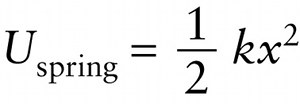Chapter 17. Spring potential energy (6-19)
Question
TvcK4MaGCUeRLEUoZVHh1qLGQNsT3tvyWeKr9Gbm2QvXeWW8T6v8TX1ZCgwZ1iGtYZnx6AfB3wux6diQqWAzWhZ8p7NIE5vMMfqVTSdLdgo=
Question
PmOjXZt8ZCzvoNS2GsNVv4w+b5jj+TtqISqA0F1lx8ruOlCHnCglndDx1hn4RFJ1rBjb5w==
Question
nkhadUwTQiUZDQVfwHFGNmtsDfnOH2CjP+/pxHQXTL9pF6aC8PuWVLGSBeFjbLh5LlWj7anHxpGy3Xhr+ek4tiC3ejl0OwoBbbFqb2lQBqjjUF/+ECSF/0ueumt8ajN3XLKHjnNJT8fmF7UGOeIpuDhnf9ouKvU1
Review
The only differences between \(U_{\mathrm{electric}} = q^2/(2C)\) from Equation 17-17 and the expression in Equation 6-19 is that the spring displacement \(x\) is replaced by the charge \(q\) and the spring constant \(k\) is replaced by the reciprocal of the capacitance, \(1/C\). This similarity isn’t surprising. To add potential energy to a spring by stretching it, you have to pull against the force of magnitude \(F = kx\) that the spring exerts on you. The greater the distance that the spring is already stretched, the more force it exerts and the harder it is to stretch it further.
